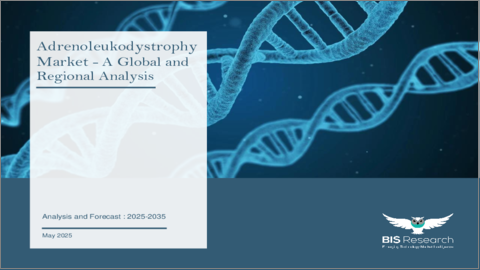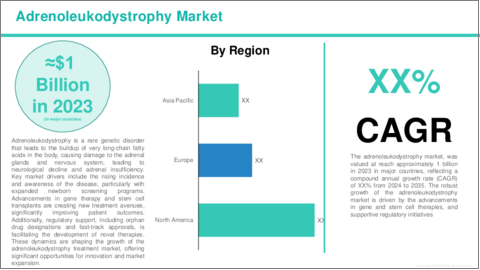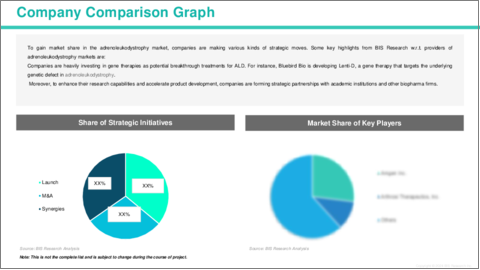|
|
市場調査レポート
商品コード
1735554
副腎白質ジストロフィーの世界市場:地域・国別の分析・予測 (2025~2035年)Adrenoleukodystrophy Market - A Global and Regional Analysis: Analysis and Forecast, 2025-2035 |
||||||
カスタマイズ可能
|
|||||||
| 副腎白質ジストロフィーの世界市場:地域・国別の分析・予測 (2025~2035年) |
|
出版日: 2025年05月29日
発行: BIS Research
ページ情報: 英文 100 Pages
納期: 1~5営業日
|
- 全表示
- 概要
- 図表
- 目次
世界の副腎白質ジストロフィーの市場は、現在ライフサイクルの成長期にあります。
治療法が限られ、認知度も低かった導入期を経て、現在では、遺伝子治療を基盤とした治療法や革新的な薬物療法の進歩により、市場への関心が高まっています。新生児スクリーニングプログラムなど、診断技術の向上により、より早期の発見が可能となり、それに伴って治療介入への需要も増加しています。さらに、希少疾病用医薬品のプログラムや、希少疾患に対する政府支援の拡大も市場成長の促進要因となっています。一方で、市場は依然としていくつかの課題を抱えています。その代表的なものが、治療コストの高さと、患者数が比較的少ないことによる市場規模の制限です。これらの要因は、急速な市場拡大を妨げる可能性があります。全体として、同市場は現在成長中ではあるものの、依然として高度に専門的な領域であり、継続的な研究開発によって希少疾患領域全体の進化に寄与していくことが期待されています。
影響
- 副腎白質ジストロフィー治療に対する需要の増加が予測期間中の世界の副腎白質ジストロフィー市場の成長を後押しする見通し
- 標的治療の進展、認知度と診断率の上昇、臨床開発パイプラインの拡充に加え、医療インフラの整備や専門的治療へのアクセス向上などの要因により、世界のALD市場は今後大きな成長を遂げる見込み
最近の動向
- 研究活動:2024年12月、Minoryx TherapeuticsとNeuraxpharm Groupは、脳性副腎白質ジストロフィーの小児患者を対象としたNEXUS試験において、leriglitazone が主要評価項目を達成したと発表
当レポートでは、世界の副腎白質ジストロフィーの市場を調査し、主要動向、市場影響因子の分析、法規制環境、臨床試験の動向、市場規模の推移・予測、各種区分・地域/主要国別の詳細分析、競合情勢、主要企業のプロファイルなどをまとめています。
目次
エグゼクティブサマリー
第1章 世界の副腎白質ジストロフィー市場:概要
- 業界展望
- 市場概要とエコシステム
- 市場動向
- 副腎白質ジストロフィーの疫学的分析
- 臨床試験
- 規制状況/コンプライアンス
- 市場力学
- 影響分析
- 市場促進要因
- 市場抑制要因
- 市場機会
第2章 世界の副腎白質ジストロフィー市場:地域別
- 北米
- 欧州
- アジア太平洋
- 市場力学
- 市場規模・予測
第3章 世界の副腎白質ジストロフィー市場:競合ベンチマーキング・企業プロファイル
- 競合情勢
- 各社の主要戦略と展開
- 主な展開の分析
- 企業プロファイル
- bluebird bio
- Minoryx Therapeutics, S.L.
- MedDay Pharmaceuticals
- Viking Therapeutics
- Neuraxpharm Group
第4章 調査手法
List of Figures
- Figure: Global Adrenoleukodystrophy Market, Market Overview
- Figure: Global Adrenoleukodystrophy Market, Epidemiological Analysis, U.S.
- Figure: Global Adrenoleukodystrophy Market Coverage
- Figure: Global Adrenoleukodystrophy Market Key Trends, Impact Analysis, 2023-2035
- Figure: Global Adrenoleukodystrophy Market, Competitive Landscape, January 2022-April 2025
List of Tables
- Table: Global Adrenoleukodystrophy Market, Regulatory Scenario
- Table: Global Adrenoleukodystrophy Market Dynamics, Impact Analysis
- Table: Global Adrenoleukodystrophy Market (by Region), $Million, 2023-2035
Industry Overview
The global adrenoleukodystrophy market is currently in the growth stage of its lifecycle. Having transitioned from the introduction phase, where treatment options were limited and awareness was low, the market is now experiencing increased interest due to advances in gene therapy-based treatments and innovative drug therapies. Rising diagnostic capabilities, such as newborn screening programs, have contributed to earlier detection, driving demand for therapeutic interventions. Furthermore, the emergence of orphan drug programs and government support for rare diseases has spurred market growth. However, the market still faces challenges, including high treatment costs and a relatively small patient base, which may limit rapid expansion. Overall, while the market is growing, it remains highly specialized and will continue to evolve the rare disease landscape with ongoing research and development.
Impact
- Increasing demand for adrenoleukodystrophy therapies is anticipated to support the growth of the global adrenoleukodystrophy market during the forecast period 2025-2035.
- The global adrenoleukodystrophy market is expected to grow at a significant rate due to developments in targeted therapies, rising awareness and diagnosis, and a growing clinical pipeline, alongside advancements in healthcare infrastructure and access to specialized treatments.
Recent Developments
- Research Activities: In December 2024, Minoryx Therapeutics and Neuraxpharm Group announced that leriglitazone met the primary endpoint in the NEXUS trial for paediatric patients with cerebral adrenoleukodystrophy (cALD).
Demand - Drivers and Limitations
Drivers:
- Increasing Prevalence of Adrenoleukodystrophy
- Advancements in Treatment Options
- Growing Research and Investment in Rare Diseases
Limitations:
- High Treatment Costs
- Limited Awareness in Developing Regions
How Can This Report Add Value to an Organization?
Product/Innovation Strategy: Innovations in the global adrenoleukodystrophy market are centered on advancing treatment options to enhance patient care. Key players in the market, such as Minoryx Therapeutics and NeuraxPharm, have been involved in the development of therapies for adrenoleukodystrophy.
Competitive Strategy: Enterprises led by market leaders continually update their product portfolios with innovative treatments to maintain competitiveness. A detailed competitive benchmarking of the key players has been conducted, providing insights into how these companies compare in terms of product pipeline and innovation. This benchmarking provides readers with a clear understanding of the market landscape and the positions of the leading players. Additionally, comprehensive competitive strategies, such as partnerships, agreements, and collaborations, will help readers identify untapped revenue opportunities in the market.
Key Market Players and Competition Synopsis
The companies profiled have been selected based on inputs gathered from primary experts and by analyzing company coverage, product portfolios, and market penetration.
Some of the prominent names established in this market are:
- bluebird bio
- Minoryx Therapeutics, S.L.
- MedDay Pharmaceuticals
- Viking Therapeutics
- Neuraxpharm Group
Table of Contents
Executive Summary
Scope of Study
1. Global Adrenoleukodystrophy Market Overview
- 1.1 Industry Outlook
- 1.1.1 Market Overview and Ecosystem
- 1.1.2 Market Trends
- 1.1.3 Epidemiological Analysis of Adrenoleukodystrophy
- 1.1.4 Clinical Trials
- 1.1.4.1 By Phase
- 1.1.4.2 By Sponsor Type
- 1.1.5 Regulatory Landscape / Compliance
- 1.2 Market Dynamics
- 1.2.1 Impact Analysis
- 1.2.2 Market Drivers
- 1.2.3 Market Restraints
- 1.2.4 Market Opportunities
2. Global Adrenoleukodystrophy Market (By Region), $Million, 2023-2035
- 2.1 North America
- 2.1.1 Market Dynamics
- 2.1.2 Market Size and Forecast
- 2.1.2.1 North America Adrenoleukodystrophy Market (by Country)
- 2.1.2.1.1 U.S.
- 2.1.2.1 North America Adrenoleukodystrophy Market (by Country)
- 2.2 Europe
- 2.2.1 Market Dynamics
- 2.2.2 Market Size and Forecast
- 2.2.2.1 Europe Adrenoleukodystrophy Market (by Country)
- 2.2.2.1.1 U.K.
- 2.2.2.1.2 Germany
- 2.2.2.1.3 France
- 2.2.2.1.4 Italy
- 2.2.2.1.5 Spain
- 2.2.2.1 Europe Adrenoleukodystrophy Market (by Country)
- 2.3 Asia-Pacific
- 2.3.1 Market Dynamics
- 2.3.2 Market Size and Forecast
- 2.3.2.1 Asia-Pacific Adrenoleukodystrophy Market (by Country)
- 2.3.2.1.1 Japan
- 2.3.2.1 Asia-Pacific Adrenoleukodystrophy Market (by Country)
3. Global Adrenoleukodystrophy Market - Competitive Benchmarking and Company Profiles
- 3.1 Competitive Landscape
- 3.1.1 Key Strategies and Developments by Company
- 3.1.1.1 Funding Activities
- 3.1.1.2 Mergers and Acquisitions
- 3.1.1.3 Regulatory Approvals
- 3.1.1.4 Partnerships, Collaborations and Business Expansions
- 3.1.2 Key Developments Analysis
- 3.1.1 Key Strategies and Developments by Company
- 3.2 Company Profiles
- 3.2.1 bluebird bio
- 3.2.1.1 Company Overview
- 3.2.1.2 Product Portfolio
- 3.2.1.3 Target Customers/End Users
- 3.2.1.4 Analyst View
- 3.2.2 Minoryx Therapeutics, S.L.
- 3.2.2.1 Company Overview
- 3.2.2.2 Product Portfolio
- 3.2.2.3 Target Customers/End Users
- 3.2.2.4 Analyst View
- 3.2.3 MedDay Pharmaceuticals
- 3.2.3.1 Company Overview
- 3.2.3.2 Product Portfolio
- 3.2.3.3 Target Customers/End Users
- 3.2.3.4 Analyst View
- 3.2.4 Viking Therapeutics
- 3.2.4.1 Company Overview
- 3.2.4.2 Product Portfolio
- 3.2.4.3 Target Customers/End Users
- 3.2.4.4 Analyst View
- 3.2.5 Neuraxpharm Group
- 3.2.5.1 Company Overview
- 3.2.5.2 Product Portfolio
- 3.2.5.3 Target Customers/End Users
- 3.2.5.4 Analyst View
- 3.2.1 bluebird bio






